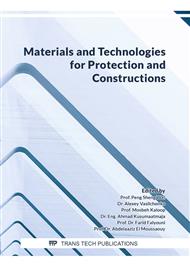[1]
Sohrabi M J, Naghizadeh M, Mirzadeh H. Deformation-induced martensite in austenitic stainless steels: A review[J]. Archives of Civil and Mechanical Engineering, 2020, 20:124.
DOI: 10.1007/s43452-020-00130-1
Google Scholar
[2]
Tsuge S. Recent Advances in Stainless Steel[J]. Reference Module in Materials ence and Materials Engineering, (2020).
Google Scholar
[3]
Reck B.K, Chambon M, Hashimoto S, et al. Global Stainless Steel Cycle Exemplifies China's Rise to Metal Dominance[J]. Environmental Science & Technology, 2010, 44(10):3940.
DOI: 10.1021/es903584q
Google Scholar
[4]
Blitz B, Lipp W. China stainless steel crude production: Over 20 million tonnes in 2013![J]. Stainless steel world, (2014).
Google Scholar
[5]
Outteridge T, Kinsman N, Ronchi G, etc. Editorial: Industrial relevance of molybdenum in China [J]. Advances in Manufacturing, 2020, 8(1):35-39.
DOI: 10.1007/s40436-019-00270-5
Google Scholar
[6]
Wang C, Hao J, Kang J, et al. Tailoring the Microstructure of Coarse-Grained HAZ in Steel for Large Heat Input Welding: Effect of Ti-Mg-Ce-V Inclusion/Precipitation Particles[J]. Metallurgical and Materials Transactions A, 2021, 52(8):3191-3197.
DOI: 10.1007/s11661-021-06321-6
Google Scholar
[7]
Fan M, Shao C, Wang Y, et al. In-situ DIC investigation on local stress-strain behavior in creep-fatigue test of dissimilar steel welded joint[J]. International Journal of Fatigue, 2021, 152(1-3): 106464.
DOI: 10.1016/j.ijfatigue.2021.106464
Google Scholar
[8]
Wang Y, Zhang W, Wang Y, et al. Experimental Evaluation of Localized Creep Deformation in Grade 91 Steel Weldments[J]. Materials Science and Engineering A, 2021, 799: 140356.
DOI: 10.1016/j.msea.2020.140356
Google Scholar
[9]
Gong K, Wu M, Xie F, et al. Effect of Cl and rust layer on stress corrosion cracking behavior of X100 steel base metal and heat-affected zone in marine alternating wet/dry environment[J]. Materials Chemistry and Physics, 2021, 270124826.
DOI: 10.1016/j.matchemphys.2021.124826
Google Scholar
[10]
Joutoku K, Osuki T, Hirata H, et al. Segregation behavior at grain-boundary in HAZ of fully austenitic stainless steel: Development of numerical model to predict of HAZ cracking susceptibility on fully austenitic high alloy steel(Report 5)[J]. Journal of Dental Research, 1971, 50(2):199-204.
DOI: 10.1002/eng2.12308/v2/review2
Google Scholar



